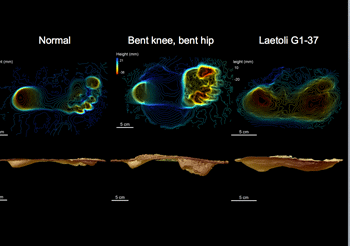- Home
- /
- UAlbany News
- /
- Release
- /
UAlbany Anthropologist's Study of 3.6 Million-Year-Old Fossil Footprints Reveals Tree-Dwelling Ancestors Walked Like Modern Humans
Contact(s): Catherine Herman (518) 956-8150
 |
Difference in relative heel and toe depths as seen in normal human walking, crouched human walking, and the 3.6-million-year-old prints from Laetoli, Tanzania. (Illustration courtesy Adam Gordon) |
ALBANY, N.Y. (March 19, 2010) -- The ancestors of modern humans developed an upright posture and modern, human-like striding gait 3.6 million years ago, at a time when they still spent a significant amount of time in trees.
University at Albany anthropology professor Adam Gordon and research colleagues at the University of Arizona and Lehman College (CUNY) show the earliest direct evidence of early hominins using the kind of efficient, upright posture and gait now seen in modern humans. The research appears in the Monday, March 22 edition of the online journal PLoS ONE.
A trackway of fossil footprints preserved in volcanic ash deposited 3.6 million years ago was found in Laetoli, Tanzania more than 30 years ago, and the significance of those prints for human evolution has been debated ever since. The most likely individuals to have produced the footprints, which show clear evidence of walking on two legs (known as bipedalism), would have been members of the only bipedal species alive in the area at that time, Australopithecus afarensis, a species which famously includes the "Lucy" skeleton.
A number of features in the hips, legs, and back of this species indicate that it would have walked on two legs when on the ground, but curved fingers and toes as well as an upward-oriented shoulder blade provide good evidence that Lucy and other members of her species would have spent a significant amount of time in the trees. This morphology differs distinctly from members of our own genus, Homo, who abandoned the trees around 2 million years ago and committed to fully human-like bipedalism.
Since the Laetoli tracks were discovered, scientists have debated whether they indicate a modern human-like mode of striding bipedalism, or a less-efficient type of crouched bipedalism more characteristic of chimpanzees in which the knee and hip are bent when walking on two legs.
In order to produce the first published biomechanical experiment explicitly designed to address this question, the team built a sand trackway in the motion capture lab of lead author David Raichlen at the University of Arizona. Human subjects were filmed walking across the sand with normal, erect gaits and crouched, chimpanzee-like gaits. Three-dimensional models of the footprints were then collected and analyzed by Adam Gordon using equipment brought from his Primate Evolutionary Morphology Laboratory at the University at Albany.
The researchers looked at the relative depth of footprints at the heel and toe, and determined that depths are about equal when made by a person walking with an erect gait, while the toe print is much deeper than the heel print when produced by a crouched gait, a product of the timing of weight transfer over the length of the foot.
�Based on previous analyses of the skeleton of Australopithecus afarensis, we expected that the Laetoli footprints would resemble those of someone walking with a bent knee, bent hip gait typical of chimpanzees, and not the striding gait normally used by modern humans,� Raichlen said. "But to our surprise, the Laetoli footprints fall completely within the range of normal human footprints.�
The fossil footprints at Laetoli preserve a remarkably even depth at the toe and heel, just like those of modern humans. Raichlen added, "This more human-like form of walking is incredibly energetically efficient suggesting that reduced energy costs were very important in the evolution of bipedalism prior to the origins of our own genus, Homo.�
If the Laetoli footprints were made by Lucy�s species, as most scientists agree to be the case, these results have implications for the timing of evolutionary events.
�What is fascinating about this study is that it suggests that, at a time when our ancestors had an anatomy well-suited to spending a significant amount of time in the trees, they had already developed a highly efficient, modern human-like mode of bipedalism,� Gordon said. �The fossil record indicates that our ancestors did not make a full-time commitment to leaving the trees and walking on the ground until well over a million years after these prints were made. The fact that partially tree-dwelling animals like Lucy had such a remarkably modern gait is a testament to the importance of energetic efficiency in moving around on two legs.�
�Laetoli Footprints Preserve Earliest Direct Evidence of Human-like Bipedal Biomechanics� by David A. Raichlen, Adam D. Gordon, William E.H. Harcourt-Smith, Adam D. Foster, and Wm. Randall Haas Jr. will be published in PLoS ONE on Monday, March 22.
![]() For more news, subscribe to UAlbany's RSS headline feeds
For more news, subscribe to UAlbany's RSS headline feeds
Educationally and culturally, the University at Albany-SUNY puts "The World Within Reach" for its 18,000 students. An internationally recognized research university with 58 undergraduate majors and 128 graduate degree programs, UAlbany is a leader among all New York State colleges and universities in such diverse fields as public policy, nanotechnology and criminal justice. With a curriculum enhanced by 300 study-abroad opportunities, UAlbany launches great careers. For more information about this globally ranked University, visit www.albany.edu. For UAlbany's extensive roster of faculty experts, visit www.albany.edu/news/experts.shtml.


